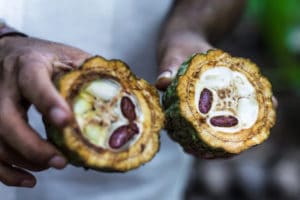
We may equate the “origin of chocolate” with our favorite local chocolatier, those “across the pond” or a major candy brand, but the truth is our chocolate has traveled many miles before we take that first bite. Chocolate is truly a global experience without having to leave our home towns. And especially this year, that is a sweet treat.
A multitude of hands working hard work across the globe makes it possible for us to enjoy that first bite. The basic ingredients of any dark chocolate start with the cocoa bean as the chocolate liquor (liquid), cocoa butter and cocoa powder are derived from the bean. Even though cocoa was native to the Americas and a valuable crop in the earliest South American cultures, today the majority of cocoa is produced in tropical areas around the Equator. In fact, about 70% of the world’s cocoa beans (about 2.6 million tons of cocoa produced annually) come from four West African countries: Ivory Coast, Ghana, Nigeria and Cameroon, with the majority being produced by small farmers living in poverty. According to the World Cocoa Foundation, a typical cocoa farmer in West Africa works on a plot of no more than 3.5 hectares (or 8.7 acres) and uses income gained from cocoa to support between six and eight family members. It is estimated that more than two-thirds of cocoa farmers live below the poverty line in some African cocoa growing countries.3

So, the next time, you pick up a piece of chocolate to eat, think about the intertwined global network that created that moment of bliss. It’s not only cocoa farmers of West Africa that we need to thank, but also farmers in the United States, Canada, Mexico, and parts of Asia that grow the sugar beets or sugar cane that give chocolate its sweetness and vanilla bean growers in Mexico, Indonesia, Madagascar or Tonga that provide added flavor.
Chocolate, like so many food products we enjoy, takes many hands to produce. Enjoy your chocolate (in small amounts, of course) and know there’s a world of farmers that appreciate you. Send your love to all that grow our food!
References:
1. “Chocolate and Candy to Play Central Role in Valentine’s Day 2021,” National Confectioners Association, February 1, 2021.
2. “How Many Pounds of Chocolate Do Americans Buy for Valentine’s Day?” by Carolyn Menyes, The Daily Meal, February 5, 2020.
3. “Prosperous Farmers: The World Cocoa Foundation and our members work to improve the livelihoods of cocoa farmers around the world,” World Cocoa Foundation.
